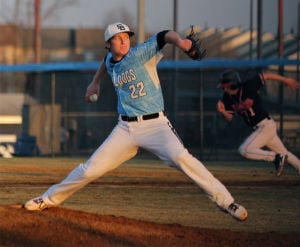I checked JB's PG profile page and found that David Rawnsley had just posted this draft report on him yesterday:
Position: RHP
Height: 6-1
Weight: 195
Bats/Throws: R-R
Birthdate: Oct. 11, 1996
High School: Stone Bridge
City, State: Ashburn, Va.
Travel Team: EvoShield Canes
Commitment: North Carolina
Projected Draft Round: 1-1S
Perfect Game’s Jeff Dahn wrote an outstanding background piece on North Carolina righthanded pitcher Jacob Bukauskas in mid-April, detailing both the intense lower body strengthening that has caused his dramatic increase in velocity and his reclassification into the 2014 class.
This Draft Focus article will attempt to delve into a couple of other aspects of Bukauskas’ overall profile and his rise to potential first round status.
The eligibility rules for a high school player for the Major League Baseball Draft have remained relatively stable over the decades, which doesn’t mean that there haven’t been a small handful of exceptions. The rule basically states that any player who has used up his his high school eligibility, and/or has graduated from high school and not yet attended college, is eligible for selection.
Jeremy Bonderman was perhaps the first player to become an exception to this rule when he was selected by the A’s in the first round out of Pasco (Wash.) High School in 2001. The righthanded pitcher had been held back for academic reasons prior to high school before being diagnosed with dyslexia and was older than his peer group. He successfully petitioned Major League Baseball for draft eligibility after having to temporally drop out of school, take and pass his GED exam, then return to school to pitch his junior year nearing his 19thbirthday.
MLB was not happy with this development and adjusted its rules interpretation manual, a non-public document that teams use internally on a number of potential issues, to try to keep it from happening again.
Bryce Harper used a similar track to become eligible for the 2010 draft, although for different reasons. Harper’s baseball prodigy status made high school baseball relatively meaningless and he took the GED after his sophomore season at Las Vegas High School so he could enter the College of Southern Nevada for the 2009-2010 school year and become eligible for the 2010 draft. Junior college baseball, even with wood bats at CSN, proved to be equally lacking in challenges, and Harper was the first pick in the 2010 draft and an All-Star before his 20thbirthday.
Drew Ward, however, is really the exception that Bukauskas’reclassifying from the 2015 class to the 2014 class takes precedent from. Ward, like Bonderman, was an older high school junior who played at a very small rural Oklahoma high school. He took extra classes, including online classes through the University of Oklahoma, in order to graduate in three years and make himself draft eligible. MLB granted him his eligibility in the middle of last spring, contingent on him graduating, and Ward was picked in the third round by the Washington Nationals.
MLB took a step back after the Ward situation and acknowledged the basis of the rules and the reality of the situation, according to multiple sources, opening the door for Bukauskas to have a relatively stress-free transition from a potential 2015 draftee to a 2014 eligible player.
The irony, as Dahn describes in his story on Bukauskas, is that he and his family had no intention of graduating early with a focus on the draft. Their intent was always to accelerate the schedule to attending North Carolina.
That intent may still be valid and on the table, but it has been obviously side-tracked by Bukauskas’ emergence as perhaps the second hardest throwing high school arm in the 2014 class behind Texas righthander Tyler Kolek.
Therein lies the second irony. Bukauskas made his mark as a pitcher prior to this spring as a dominant performance pitcher who used a well-balanced three-pitch repertoire and an aggressive command of the strike zone to overmatch hitters, not overpowering velocity.
Bukauskas threw at numerous Perfect Game events prior to this spring, including both the 2012 and 2013 Junior National Showcases, the latter of which he topped out at 93 mph. However, his signature PG event was his final one, the 2013 PG Underclass All-American Games last August. That heavily scouted event, held the day after the Perfect Game All-American Classic, has a very high level of talent, talent that Bukauskas completely dominated. Here are my notes from his outing at the University of San Diego.
On line delivery with good pace, gathers over rubber, accelerates to the plate, occasional running action, commands SL well, some SL's have CB spin/shape/depth, quick compact arm, hi 3/4's, best life down, consistent 88-9 gets on hitters hands, late bite to glove side, throws to spots, K'd 6 straight at one point and overmatched many, nice change with big sink, overthrows at times and lowers slot, + change at times with + life, maintained velocity, topped at 90 mph, potential for 3 plus pitches.
Now take the same type of delivery, secondary pitches and command and put them with a pitcher throwing 94-97 and touching 100 mph instead of upper-80s. That is an impressive package.
How that package will play come June 5 makes Bukauskas one of the biggest wild cards in the draft. The decision making scouts will have had a chance to see him the second half of this spring, but they won’t have the depth of looks and resume that Bukauskas’ new peer group, pitchers such as Grant Holmes, Touki Toussaint and Sean Reid-Foley, have established. It’s easy to imagine Bukauskas hearing his name called in the first half of the first round, but it wouldn’t be surprising to have to wait until the compensation round as well.
All it takes, as they say, is the one team that likes you the most.

